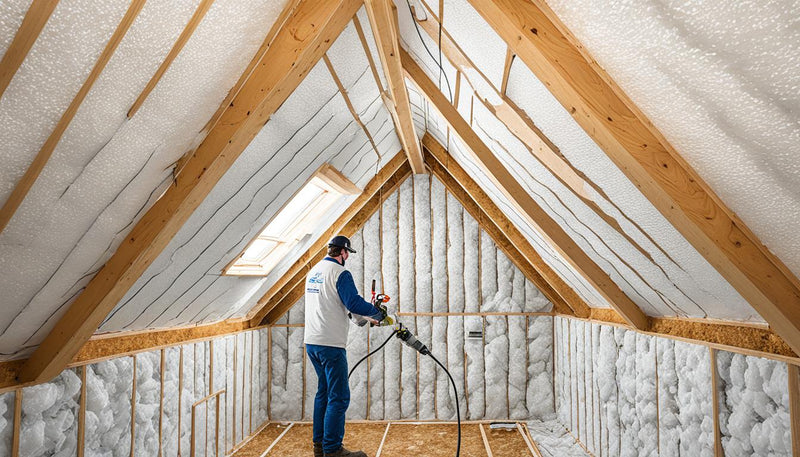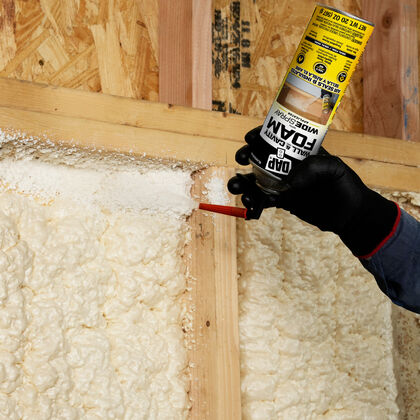Frequently Asked Questions Regarding Spray Foam Installation and Usage
Frequently Asked Questions Regarding Spray Foam Installation and Usage
Blog Article
Spray Foam: The Ultimate Remedy for Air Sealing and Insulation
Spray foam insulation has emerged as a leading solution for effective air sealing and thermal insulation, using a distinct combination of buildings that establish it apart from traditional methods. Comprehending the full scope of its benefits, installation processes, and contrasts with other insulation types is essential for making notified choices.
What Is Spray Foam?
Spray foam is a flexible insulation product that combines the principles of air sealing and thermal resistance to enhance power performance in structures. Made up mostly of polyurethane or various other similar compounds, spray foam is used as a liquid that broadens upon call with surfaces, creating a strong, continuous layer of insulation. This one-of-a-kind building allows it to fill voids, fractures, and voids that traditional insulation materials might overlook, offering a premium air seal.
There are two main kinds of spray foam: open-cell and closed-cell. Open-cell spray foam is lighter and extra flexible, providing superb sound absorption and a reduced R-value per inch - Spray Foam. On the other hand, closed-cell spray foam is denser, providing a higher R-value, dampness resistance, and included structural honesty to constructing parts
The application procedure usually entails specialized devices, ensuring a smooth application that sticks to different substrates, consisting of wood, steel, and concrete. This adaptability makes spray foam appropriate for both brand-new constructions and retrofitting existing frameworks. Its capacity to produce an airtight obstacle substantially adds to decreasing power usage and improving indoor air high quality, thereby making it a preferred option amongst building contractors and home owners alike.
Benefits of Spray Foam Insulation
One of one of the most significant benefits of spray foam insulation is its remarkable capacity to develop a continuous air barrier, which properly minimizes power loss. Unlike standard insulation materials, spray foam broadens to load gaps and splits, guaranteeing that air leak is substantially minimized. This characteristic not just improves power efficiency however also causes lower energy expenses gradually.
Additionally, spray foam insulation provides exceptional thermal resistance, adding to a more secure interior atmosphere. Its high R-value per inch permits efficient insulation in constrained areas, making it suitable for attic rooms, wall surfaces, and crawl rooms. The moisture-resistant buildings of spray foam aid stop mold and mildew and mildew development, advertising healthier living conditions.
An additional important benefit of spray foam insulation is its sound-dampening top qualities (Spray Foam). It effectively decreases sound transmission in between spaces, producing a quieter and more comfy home atmosphere. The toughness of spray foam additionally sticks out, as it does not droop or settle in time, preserving its performance throughout its life-span
How Spray Foam Works
Understanding how spray foam insulation functions is important for appreciating its effectiveness in air sealing and thermal resistance. Spray foam insulation includes 2 key components: isocyanate and polyol material. When these parts are mixed, they go through a chain reaction that creates the product to increase quickly, creating a dense foam that fills spaces, dental caries, and cracks.
As the foam increases, it follows surfaces, developing an impermeable seal that significantly decreases air infiltration. This characteristic makes spray foam insulation very effective at avoiding drafts and moisture infiltration, which can lead to energy loss and damages gradually. Furthermore, the closed-cell variation of spray foam uses premium thermal resistance due to its rigid framework, efficiently lessening warmth transfer.
The distinct buildings of spray foam allow it to comply with irregular surface areas, making certain detailed coverage and a smooth barrier. Consequently, spray foam insulation not just improves power performance but also adds to boosted indoor air high quality by reducing the accumulation of allergens and toxins. Eventually, comprehending the auto mechanics behind spray foam underscores its duty as a premium option for insulation and air look at this web-site sealing in both domestic and industrial applications.
Installation Refine Summary

Before installment, the area should be effectively cleaned up and prepped, guaranteeing that surfaces are totally free from wetness, debris, and dirt. Due to the fact that pollutants can endanger adhesion and overall performance, this action is critical. When the area is prepared, the application involves mixing both elements of the spray foam, which increases upon call and loads gaps efficiently.
Trained specialists ought to carry out the setup, making use of specialized devices to guarantee consistent insurance coverage and optimum density. Safety and security preventative measures, consisting of putting on safety gear and making certain appropriate ventilation, are crucial throughout this process. After application, the foam usually remedies rapidly, forming a solid obstacle that boosts power performance.
Comparing Spray Foam to Typical Insulation
When reviewing insulation options, spray foam insulation attracts attention in contrast to standard materials such as fiberglass and cellulose. One of the key benefits of spray foam is its exceptional air sealing capacities. Unlike fiberglass and cellulose, which can permit air infiltration, spray foam expands upon click over here now application, filling voids and gaps to develop an impermeable seal. This leads to improved energy effectiveness, as less warmed or cooled down air gets away the home, bring about reduced utility expenses.
In addition, spray foam provides a greater R-value per inch than conventional insulation kinds, offering more efficient thermal resistance in a thinner account. This characteristic is especially beneficial in spaces with limited dental caries depth. Spray foam is immune to wetness and mold growth, which can be a substantial problem with cellulose and fiberglass, particularly in moist settings.
Nonetheless, spray foam insulation normally carries a greater upfront expense than its conventional counterparts. House owners need to evaluate this first investment against long-lasting power savings and performance benefits. Eventually, while both insulation kinds offer their purpose, spray foam emerges as an advanced solution for modern-day insulation needs, especially in terms of air sealing and thermal effectiveness.

Final Thought
In recap, spray foam insulation stands for an extremely effective service for attaining optimal air securing and thermal resistance. Its one-of-a-kind properties, including moisture resistance and noise dampening, make it appropriate for different applications in both brand-new constructions and retrofitting projects (Spray Foam). Although the preliminary prices may be higher contrasted to traditional insulation products, the lasting benefits, such as considerable energy financial savings and improved indoor air quality, justify the More Info investment and highlight its value in modern building methods.
Spray foam insulation has emerged as a leading service for effective air sealing and thermal insulation, supplying a special mix of homes that establish it apart from conventional methods.Spray foam is a versatile insulation material that integrates the principles of air sealing and thermal resistance to enhance energy efficiency in buildings.When examining insulation choices, spray foam insulation stands out in comparison to typical materials such as fiberglass and cellulose. Ultimately, while both insulation kinds offer their objective, spray foam arises as a much more advanced remedy for contemporary insulation requirements, particularly in terms of air sealing and thermal efficiency.
In recap, spray foam insulation stands for an extremely effective solution for attaining optimum air securing and thermal resistance.
Report this page